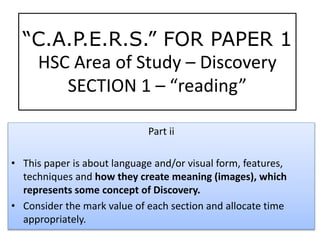
Capers forAoS paper 1 part ii
- 1. Part ii • This paper is about language and/or visual form, features, techniques and how they create meaning (images), which represents some concept of Discovery. • Consider the mark value of each section and allocate time appropriately. “C.A.P.E.R.S.” FOR PAPER 1 HSC Area of Study – Discovery SECTION 1 – “reading”
- 2. Use connecting words such as: • by comparison… • by contrast… • a parallel can be drawn with… • a similar technique/idea is used in… • another way of portraying the concept of discovery is shown in… • ‘Prepared answers’ that are regurgitated vague concept statements DO NOT answer the questions sufficiently to expect full marks. • The structure of this paper and the questions is designed to test your knowledge and understanding, not your memory. The focus of your text-analysis is ONLY on the concept of DISCOVERY. Don’t simply make a brief link at end, almost as an afterthought. Integrate your connections throughout your response.
- 3. Quotes: • should not be used in isolation • require explanation • Integrated into a cohesively developed response, which provides equal balance to the included texts. • should be short, succinct, relevant and explained with specific and fully-developed sentences. General tips
- 4. “[insert name of text] is a poem which explores the concept that self- discovery can be highly emotional and confronting(Concept). The metaphor (ANALYSE) in “insert quotation from text”(Prove with Evidence) creates a powerful sensory image( ANALYSE) of the pain and desperation experienced by the persona. This clearly depicts the concept that the initial catalyst to personal discovery can be extremely emotional and confronting (Respond with Syllabus) .…” C.A.P.E.R.S. Concept + ANALYSE + Prove with Evidence + Respond with Syllabus (words) …do not simply retell The text in blue integrated the effect of the technique MUST be included BEFORE you link the quote to the concept of discovery!!
- 5. “In [insert name of the text] the webpage explores the concept that the consequences of discoveries can vary according to personal contexts and values of individuals [C]. The mid-shot [A] in the foreground [A] of the photograph [A] focuses on the relaxed and open body language [A] of the older female [PE] in the visual text “insert name of text”. The relaxed pose [PE] of the female [PE] contrasts [A] with the close-up [A] of the worried [PE] facial expressions [A] of the younger male [PE] in the mid-ground [A]. The younger man is depicted as being uncomfortable and anxious about the change he is experiencing. It would appear that, according to the “insert name of the text”, older women with more life experience are more open to accept the changes that accompany new discoveries. The juxtaposition [A] of emotion suggests that different contexts and perspectives [RS] can influence the respective processes and consequences of attitudinal discovery [RS].” C.A.P.E.R.S. Concept + ANALYSE + Prove with Evidence + Respond with Syllabus (words) …do not simply retell The text in blue integrated the effect of the technique MUST be included BEFORE you link the quote to the concept of discovery!!
- 6. “The concept of discovery explored in the narrative extract [insert text name here] is that discoveries which are triggered by necessity and wonder – and which lead to re-discovered relationships – are influenced by social and cultural context and values[C] . The metaphor [A] “[insert quotation from text here]” [PE] creates an image [A] of the computer screen as being both wondrous and threatening [A] to the older, traditional family in Kenya [PE]. The metaphor [A] represents the sense of wonder and curiosity which influences this new technological discovery for a culturally- divided family which has been separated by thousands of miles and contrasting technological contexts [A].. The new discovery experienced by the traditional Kenyan family is evoked (triggered) by the curiosity, necessity and wonder of the new technology [RS]. The traditional cultural and social context of the Kenyan family impacts on their perceptions of the broader world and the family rediscovers cherished relationships [RS]. “ C.A.P.E.R.S. Concept + ANALYSE + Prove with Evidence + Respond with Syllabus (words) …do not simply retell The text in blue integrated the effect of the technique MUST be included BEFORE you link the quote to the concept of discovery!!
- 7. Become familiar with terminology such as: • images • layout (visual, written, language, font size etc) • body language (direction the people face - stance) • Facial expressions (direction of gaze – smile – tears – startled – etc…) • framing • types of shots (long, medium, close-up, extreme close-up) • composition (collage, layered) • symbolism (particularly consider this in ‘how’ a particular sign or symbol represents Discovery) • reading paths (direction, positioning) • gestures (pointing, implied direction, signs). Visual literacy techniques are as important as written language techniques.
- 8. This section is rich with language features and the texts have been carefully chosen to provide opportunities for all candidates to find, locate, describe, explain and evaluate those features such as: • structure • form (letter, poem, lyrics, web page, extract etc) • figurative (simile, metaphor, personification) • repetition • sound (alliteration, onomatopoeia, assonance) • word choice (verbs, nouns, adjectives) • dialogue • authentication (quotes from known experts to support information in interviews, articles, extracts, speeches) • integrity (statistics, sourced information (eg government). Language features in written or spoken language
- 9. Paper 1 has three sections: • each has an equal mark value to the other • The maximum time allowed for each section is 40 minutes • Use the past papers available and be proactive in developing the skill of working within a specific time frame for each section of all the papers • Walk into the examination with an air of confidence knowing that you *are* prepared and you *do* know how the “C.A.P.E.R.S.” FOR PAPER 1 Time your responses
